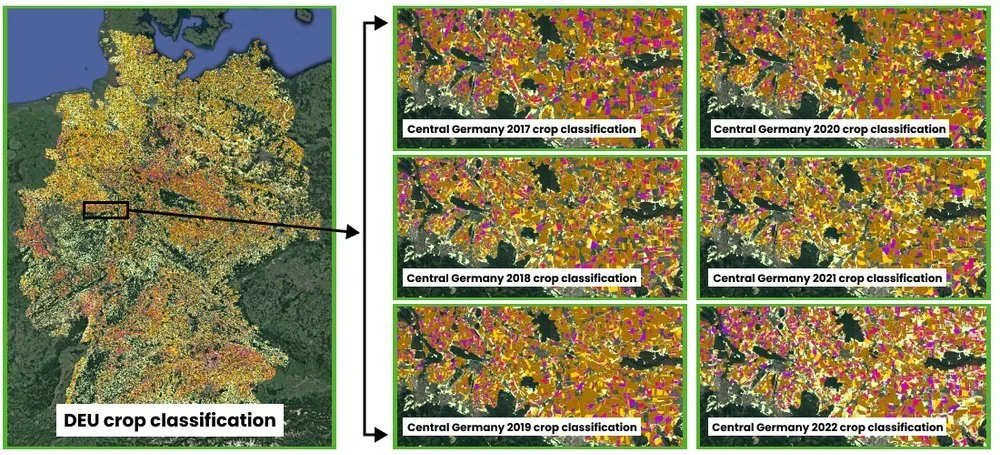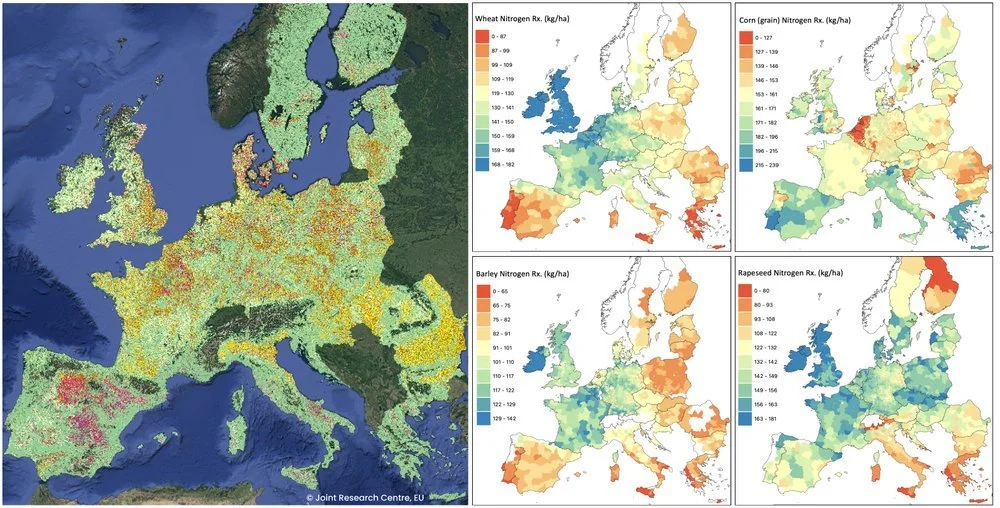Project “FertiRec”: An Innovative Solution for postcode-based fertilizer recommendations
In a world where agriculture plays a crucial role in feeding the ever-growing global population, finding sustainable and efficient ways to optimize crop production is paramount. The European Union recognized this challenge and initiated the AI4 Copernicus project, aimed at Advancing Earth Observation Intelligence, Innovation & Adoption in the field of agriculture. Among the participants, Spacenus GmbH took a pioneering role in this project, with its innovative approach towards optimizing nitrogen fertilizer recommendations.
Project overview
In the world of agriculture, it has been hard for a long time to find the right balance between giving crops the nutrients they need and keeping costs low. Farmers have had a hard time figuring out how much fertiliser to use while still following rules and getting the best crops. They have never had a greater need for low-cost recommendations that help them decide how much fertiliser to use without having to do time-consuming soil tests or buy expensive sensors. But FertiRec, an innovative new way to solve the problem, is just around the corner.
The project, which we named "FertiRec," which stands for "Postcode-based fertilizer rate recommendation," focused on revolutionizing the way farmers and agricultural retailers make crucial decisions about nitrogen (N) fertilizer application. The overarching goal was to provide precise N fertilizer recommendations for four major crops - wheat, barley, rapeseed, and corn - in Germany and the rest of the European Union based on district and postcode. This makes things easier for farmers and consultants.
Technical Excellence
AI models are used by FertiRec to get a Nutrient Use Efficiency of over 80%. These models use satellite data to make accurate estimates of what nutrients plants need, which leads to recommendations for nutrient rates at the district and post-code level.
In the past, testing the soil or plant tissue was the only way to see if a plant needed more nutrients. FertiRec, on the other hand, uses satellite imagery to deliver solutions that are both custom and scalable. The project that was paid for by AI4Copernicus helped FertiRec move forward.
One of the key milestones of the project was achieving a remarkable 90% accuracy in crop classification and 85% overall Nitrogen rate recommendation accuracy at the postcode/ district level for the selected four crops. This impressive result was obtained through meticulous data collection and advanced AI algorithms. Spacenus collected data from approximately 850,000 fields across five years and three German states: Hessen, Brandenburg, and Nord-Rhein-Westfalen.
Spacenus used the LPIS data for the three aforementioned states with 5,000 random points from the national crop map to create the crop classification dataset. In the Crop Classification research with 10m spectral resolution, Spacenus employed Sentinel-1's VV and VH bands throughout the year.
On the other hand, Spacenus employed crucial data for the N recommendation, including dry matter and nitrogen uptake information for specific postcodes. Additionally, various indices were employed with crop type information, including NDVI (Normalized Difference Vegetation Index) and NDMI (Normalized Difference Moisture Index).
Through relentless effort and innovation, the project's team managed to accomplish a crop classification accuracy rate that is essential for accurate fertilizer recommendations, thus laying the foundation for more sustainable agriculture practices.
Major Challenges and Outcomes
During the project, two major problems came up.
1) Classify crops with Sentinel-1 images.
2) Estimating the nutrient needs of each crop using Sentinel-2 images.
We initially conducted crop classification in Germany spanning the years 2017 to 2022. Subsequently, we extended our efforts to encompass crop classification for the entire European Union for the year 2018, utilizing data provided by the Joint Research Centre of the EU.
Figure: Crop classification in Germany from 2017 to 2022
After performing crop classification, Spacenus utilized a multifaceted approach to generate Nitrogen fertilizer recommendations. This process relied on two crucial maps: the Dry Matter map, which assessed plant size and growth to determine nitrogen needs, and the Nitrogen Uptake map, which measured absorbed nitrogen. These maps were fused to create precise Nitrogen Recommendation maps for wheat, barley, rapeseed, and corn in the EU based on their districts and post codes. This innovative approach enhances yields while promoting environmental sustainability by reducing excessive fertilizer use. But how can customers make the most of this great resource and add it to what they already have?
Figure: Nitrogen fertilizer recommendation for Wheat, Rapeseed, Barley and Corn for the entire European region
API
Accessing fertilizer recommendations, whether by postcodes or districts, is simple and convenient using FertiRec's API. The screenshots provided below illustrate the ease of integrating FertiRec's API into agricultural systems, enabling farmers to make data-driven decisions. We have demonstrated this integration in a practical example, which you can view in this video.
Figure: API Documentation and Demonstration
Business model
FertiRec's business model is made so that both end users and agribusinesses can benefit from it. Farmers are the end users, but agribusinesses that sell to farmers can also use the API services. FertiRec gives recommendations for Nitrogen at the district level, and there are plans to add recommendations for P2O5 and K2O at the post-code level across Europe.
FertiRec is a huge step forward for agriculture. To our knowledge, this is the first map of its kind that includes regional-specific Fertilizer rate recommendations, making it an excellent tool for policymakers, environmental specialists, Fertilizer manufacturers, retailers, food companies, water supply companies, and many more.
As we look ahead, we envision a future where this tool becomes a standard, streamlining activities ranging from policy development to environmentally conscious farming practices, climate change mitigation, and ensuring sustainable food production for all. Together, we can shape a more sustainable and prosperous future for agriculture and our planet.



